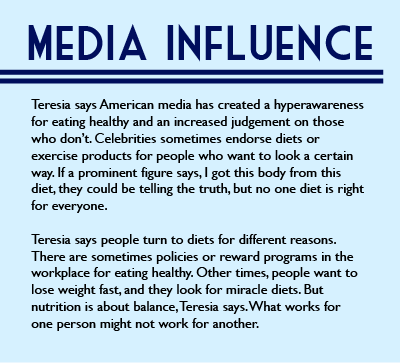Different cultures, lifestyles, and attitudes can influence how people make decisions about what to eat.
It might be easier to eat healthy if you have corn, potatoes, beans, mangos, papayas, and avocados growing in your backyard, like Teresia Mgogori did.
In Kenya—where Teresia grew up—junk food was not available the way it is in the United States. Instead, Teresia and a lot of the people she grew up with ate homegrown food. Her standard meal included boiled white corn and beans, mixed with an assortment of sauteed fruits and vegetables such as onions and tomatoes, a dish called Githeri.
According to Nations Encyclopedia, nearly 80 percent of the Kenyan workforce is involved in either agriculture or food processing. In America, only 35 percent of households grow some food at home or in a community garden, according to the National Gardening Association. But a 2016 study by Pew Research Center found that 58 percent of Americans say they should eat healthier.
Teresia decided to pursue a career in helping people stay healthy, and she is now an assistant professor of nutrition and dietetics at Ball State University. Before coming to Muncie, she studied in Kenya, Israel, and Texas. In Israel, she was introduced to the Mediterranean diet, which includes fruits, vegetables, whole grains, seafood, nuts, legumes, and olive oil. But she grew tired of the fish, preferring to stick with the rice, beans, and vegetables she knew best.
While pursuing her doctorate in nutrition sciences at Texas Tech University, international grocery stores allowed her to cook traditional African meals, like Githeri. According to TrendSource, these locations allow immigrants to maintain connections with their cultures. They often serve as places for community members to stay up to date with their home countries, offering international newspapers and advertisements. Retail sales of ethnic cooking products have increased by more than $20 million in the last seven years, according to a 2017 survey from Statista.
But Teresia doesn’t always have time to cook the meals of her childhood, and she says convenience can be an important factor in a person’s food choices.
It’s as easy as ever to eat unhealthy, she says. For example, at Little Caesars, a restaurant her family of four lives close to, customers can order online and have food delivered to their doors. The convenience is overwhelming, she says.
 Deanna Pucciarelli, an associate professor of nutrition and dietetics at Ball State, agrees that being short on time can lead people to cut corners in their health. For example, a parent might work a 12-hour shift before picking up their kids and taking them to extracurricular activities. Most households no longer have one person who stays home and prepares food, Pucciarelli says. Either no one is cooking, or the person cooking is rushed, so they might not prepare food as healthily or naturally as they could.
Deanna Pucciarelli, an associate professor of nutrition and dietetics at Ball State, agrees that being short on time can lead people to cut corners in their health. For example, a parent might work a 12-hour shift before picking up their kids and taking them to extracurricular activities. Most households no longer have one person who stays home and prepares food, Pucciarelli says. Either no one is cooking, or the person cooking is rushed, so they might not prepare food as healthily or naturally as they could.
For those who choose to eat out, most restaurants have nutrition information available to customers. Even when Teresia is indulging, she keeps track of nutritional information. Many of her conversations with friends and colleagues revolve around nutrition, as well. How many grams of sugar is in that? How many calories is that? Is it sugar-free?
However, for someone who hasn’t studied nutrition, figuring out those answers might be easier said than done. A 2013 study from the Centers for Disease Control and Prevention that rated U.S. consumers’ understanding of nutritional labels found 24 percent of people could not determine the calorie content of full ice cream containers based on the serving size. Forty-one percent could not determine the percentage daily value of calories in a single serving.
But knowing the amounts of each substance might not always make a difference, says Pucciarelli. Even if someone has the knowledge of how to structure a diet, they aren’t always going to apply it. Pucciarelli says her own eating habits change with her mental state. If she is in a bad place mentally, psychologically, or emotionally, her weight goes up. If she is in a good place, her weight goes down.
According to the American Psychological Association, 38 percent of people say they have overeaten or eaten unhealthy foods in the past month because of stress.
Others eat unhealthy food because it’s all they can afford. Some might not have money to buy foods that rot, so they buy things that are shelf-stable and high in sodium, like ramen noodles and canned goods. The U.S. Department of Health and Human Services reported nearly 45 percent of children living in poverty are overweight compared with 22 percent of children living four times above the poverty level. Additionally, the U.S. Department of Health and Human Services says more than 23 million Americans live in food deserts—areas that are more than a mile from a supermarket. So, convenience store runs for sweets are much more likely than buying ingredients for a home-cooked meal.
Teresia and her family mainly eat Kenyan food. In addition to Githeri, she’ll cook a white corn mash with sauteed kale, sometimes cabbage, and avocado. When Teresia wants to use white corn—she says yellow corn just doesn’t taste right—in her Githeri or corn mash, she has to drive from her home in Muncie to Sagara International Grocery in Indianapolis. But sometimes, when she’s too tired for the trip, she’ll opt for a slice of pizza—or three.



